十大词性 句子成分及基本句型讲解及练习(附答案)..
十大词性句子成分及基本句型讲解及练习(附问题详解)
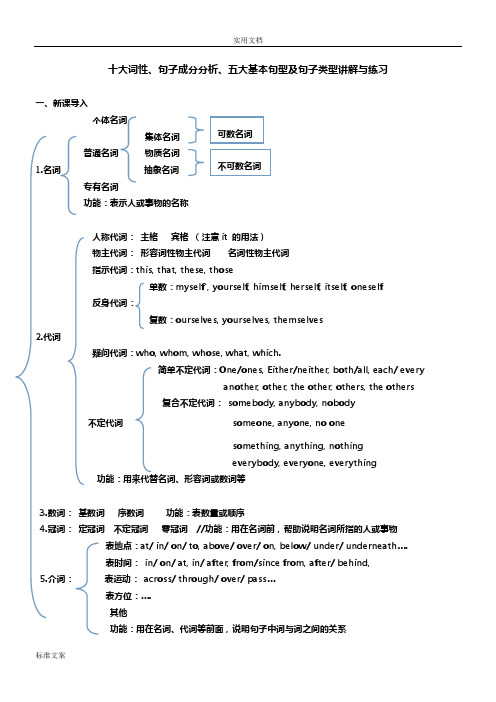
His hobby iscollecting foreign stamps. (动名词短语)
My wish isto become a doctorin the future. (不定式短语)
The news of her success is reallyexciting. (现在分词)(已形容词化)
(2)判断下列句子是简单句并列句还是复合句?
1)We often studyChinesehistory onFriday afternoon.
2)The boy who offeredme hisseat is called Tom.
3)There is a chair in this room, isn’t there?
[To hear more clearly],shesat in the front of the classroom. (不定式)
smile a sweetsmile甜甜的微笑 dream a terribledream做了一个恶梦
die a bravedeath死得英勇 live a happylife过着幸福的生活
4.表语(在系动词之后)
说明主语是什么样的。(身份 状态 特征 类属 性质等) 表语与前面的系动词一起构成谓语。
5.介词: 表运动: across/ through/ over/ pass…
表方位:….
其他
功能:用在名词、代词等前面,说明句子中词与词之间的关系
6. 形容词: 平级、比较级、最高级
功能:用来修饰名词,表示人或事物的特性、性质
7. 副词:平级、比较级、最高级
功能:用来修饰动词、形容词或其他副词,表示动作或形状的特性
英语十大词性、句子成分及五种基本句型
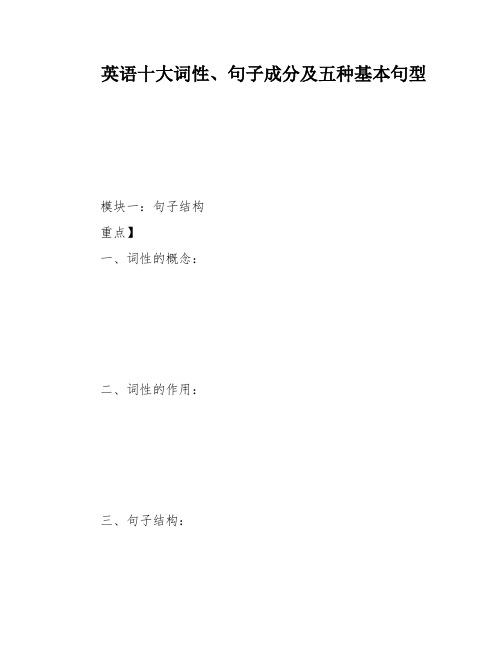
英语十大词性、句子成分及五种基本句型模块一:句子结构重点】一、词性的概念:二、词性的作用:三、句子结构:了解句子结构对于正确理解和使用英语句子同样具有重要的意义。
在写作和口语表达中,正确的句子结构可以使语言更加流畅、准确、生动。
因此,我们需要不断地练和掌握英语句子的结构,提高自己的语言表达能力。
I find the book to be too expensive。
There are five basic ___:1) S + Vi (intransitive verb) (predicate) → subject-predicate structureFor example。
"Time flies."1) S + V + adverb (adverbial)For example。
"___."2) S + Vi + nal phrase (adverbial)For example。
"He went on holiday."3) S + Vi + infinitive (adverbial)For example。
"We ped to have a rest."4) S + Vi + participle (adverbial)For example。
"I'll go swimming."2) S + Vt (transitive verb) (predicate) + O (object) → subject-predicate-object structureFor example。
"We like English."1) S + Vt + noun/pronounFor example。
"I like music."2) S + Vt + infinitive。
初中英语10大词性讲解

二、词类与句子成分关系
成分 词类
名词
主语
代词
数词
动词
形容词
副词
冠词
介词
连词
感叹词
谓语
宾语
表语
定语
状语
宾语补足 同位语 语
三、八大句子成分
句子成分:组成英语句子的各个部分,叫做句子成分。
英语的句子最多由八个句子成分组成,即: 主语、谓语、宾语、表语、定语、状语、宾语补足语 以及同位语。
宾语补足语
1、概念:用以补充说明宾语,并与宾语一起构成复合宾语的句 子成分,叫做宾语补足语。 2、位置:通常情况位于宾语之后。 3、构成:做宾语补足语的有名词、形容词、副词、动词不定式 、分词以及介词短语等。
You must keep the room clean and tidy. 你必须保持房间干净和整洁。 People see him running away. 人们看到他跑了。 Let me put this bag on the desk. 让我把这个包放在桌子上。
(副词的位置:be动词、助动词、情态动词之后,实义动词之前)
3、构成:可用作状语的有副词、动词不定式(短语)、分词
1. You are quite right. 2. They often draw in the park. 3. We came here in order to learn English.
那个穿蓝色外套的人是我妈妈。
7.The boy you will know is Tom. 你将认识的男孩叫汤姆。 8.I have something interesting to tell you. 我有一些有趣的事情告诉你。 9.The man in front of the gate is Mr. Li. 大门前的那个男人是李先生。
十大词性及名词讲解+练习
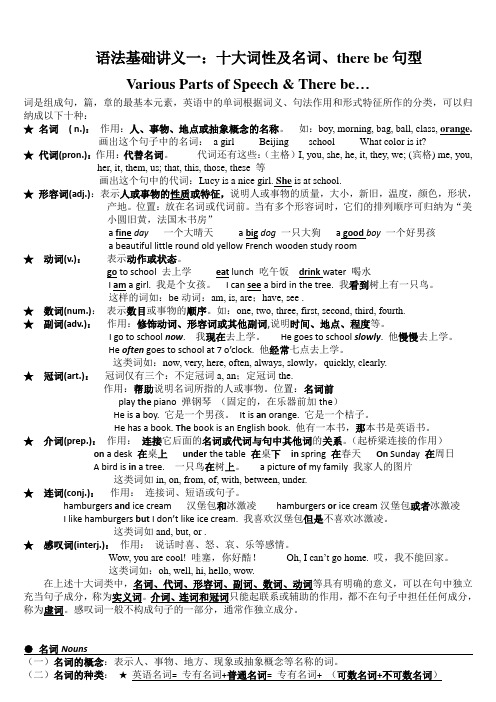
语法基础讲义一:十大词性及名词、there be句型Various Parts of Speech & There be…词是组成句,篇,章的最基本元素,英语中的单词根据词义、句法作用和形式特征所作的分类,可以归纳成以下十种:★名词( n.):作用:人、事物、地点或抽象概念的名称。
如:boy, morning, bag, ball, class, orange.画出这个句子中的名词: a girl Beijing school What color is it?★代词(pron.):作用:代替名词。
代词还有这些:(主格)I, you, she, he, it, they, we; (宾格) me, you, her, it, them, us; that, this, those, these 等画出这个句中的代词:Lucy is a nice girl. She is at school.★形容词(adj.):表示人或事物的性质或特征,说明人或事物的质量,大小,新旧,温度,颜色,形状,产地。
位置:放在名词或代词前。
当有多个形容词时,它们的排列顺序可归纳为“美小圆旧黄,法国木书房”a fine day一个大晴天 a big dog一只大狗a good boy一个好男孩a beautiful little round old yellow French wooden study room★动词(v.):表示动作或状态。
go to school 去上学eat lunch 吃午饭drink water 喝水I am a girl. 我是个女孩。
I can see a bird in the tree. 我看到树上有一只鸟。
这样的词如:be动词:am, is, are;have, see .★数词(num.):表示数目或事物的顺序。
如:one, two, three, first, second, third, fourth.★副词(adv.):作用:修饰动词、形容词或其他副词,说明时间、地点、程度等。
最新十大词性 句子成分及基本句型讲解及练习(附答案)
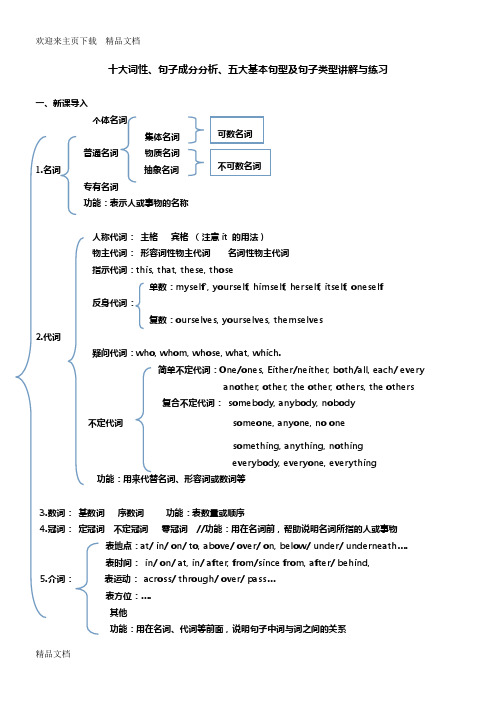
十大词性、句子成分分析、五大基本句型及句子类型讲解与练习一、新课导入个体名词集体名词普通名词 物质名词1.名词 抽象名词专有名词功能:表示人或事物的名称人称代词: 主格 宾格 (注意it 的用法)物主代词: 形容词性物主代词 名词性物主代词指示代词:this, that, these, those单数:myself`, yourself, himself, herself, itself, oneself反身代词:复数:ourselves, yourselves, themselves2.代词疑问代词:who, whom, whose, what, which.简单不定代词:One/ones, Either/neither, both/all, each/ everyanother, other, the other, others, the others复合不定代词: somebody, anybody, nobody不定代词 someone, anyone, no onesomething, anything, nothingeverybody, everyone, everything功能:用来代替名词、形容词或数词等3.数词: 基数词 序数词 功能:表数量或顺序4.冠词: 定冠词 不定冠词 零冠词 //功能:用在名词前,帮助说明名词所指的人或事物表地点:at/ in/ on/ to, above/ over/ on, below/ under/ underneath ….表时间: in/ on/ at, in/ after, from/since from, after/ behind,5.介词: 表运动: across/ through/ over/ pass …表方位:….其他功能:用在名词、代词等前面,说明句子中词与词之间的关系可数名词不可数名词6.形容词:平级、比较级、最高级功能:用来修饰名词,表示人或事物的特性、性质7. 副词:平级、比较级、最高级功能:用来修饰动词、形容词或其他副词,表示动作或形状的特性并列连词:and/ both/ or/ not only…but also, but/however/ yet/ still/ while…8. 连词:从属连词: if/ unless, because/as/ since, although/though…功能:用来连接词、短语或句子实义动词(vi./vt.)系动词助动词9. 动词:情态动词不定式(to do)非谓语动词分词: 现在分词(-ing)和过去分词(-ed)动名词(-ing)功能:表示人或事物的动作或状态10. 感叹词:oh ah well…功能:表示说话时的感情或口气课前小测:1.句子成分摸底测试:(1)指出下列句子划线部分是句子的什么成分?1)The students got on the school bus.2)He handed me the newspaper.3)I shall answer your questions after class.4)What a beautiful Chinese painting!5)They went hunting together early in the morning.(2)判断下列句子是简单句并列句还是复合句?1)We often study Chinese history on Friday afternoon.2)The boy who offered me his seat is called Tom.3)There is a chair in this room, isn’t there?4)My brother and I go to school at half past seven in the morning.5)He is in Class One and I am in Class Two.二:新课讲解:(一)句子成分七种句子成分:主语、谓语、宾语(直接宾语、间接宾语)、定语、状语、补语、表语等。
英语十大词性句子成分及五种基本句型
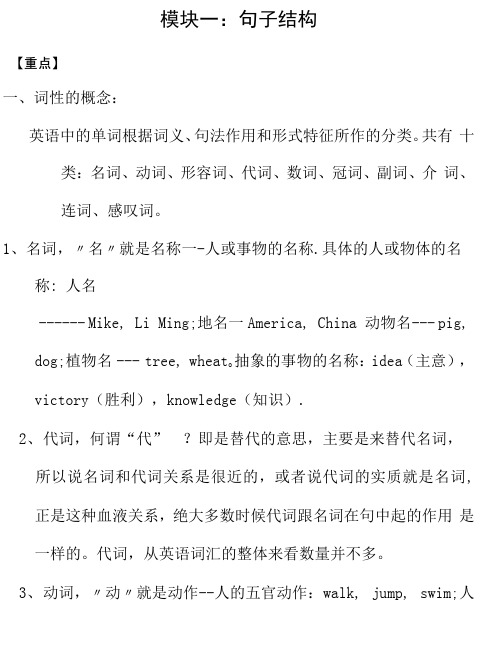
模块一:句子结构【重点】一、词性的概念:英语中的单词根据词义、句法作用和形式特征所作的分类。
共有十类:名词、动词、形容词、代词、数词、冠词、副词、介词、连词、感叹词。
1、名词,〃名〃就是名称一-人或事物的名称.具体的人或物体的名称: 人名------ Mike, Li Ming;地名一America, China 动物名--- pig, dog;植物名--- tree, wheat o抽象的事物的名称:idea(主意),victory(胜利),knowledge(知识).2、代词,何谓“代”?即是替代的意思,主要是来替代名词,所以说名词和代词关系是很近的,或者说代词的实质就是名词, 正是这种血液关系,绝大多数时候代词跟名词在句中起的作用是一样的。
代词,从英语词汇的整体来看数量并不多。
3、动词,〃动〃就是动作--人的五官动作:walk, jump, swim;人的大脑动作(心理活动):think, imagineo也有些动词是表示静止的,女口: am, is, are o4、形容词,我们在谈论人或物时,常说:“你描述一下是什么样子。
”你就要用上:tall (高的),short矮的),black (黑的), white (白的)这些词往往是修饰名词,它们就是形容词。
5、副词,说人行走得快慢,讲话清楚,在英语里就要用quicldy(快地),slowly (慢地),clearly (清楚地)这些词往往来修饰动词。
它们就是副词。
副词很多是从形容词加ly构成的,所以看单词词尾是否有ly是判断是否是副词的一种方法,但是词尾是ly的也不一定都是副词,可能是形容词,不过只有少量的单词(常见的有 likely, friendly lovely, lonely, weekly, monthly, yearly ),这几个单词需要加强记忆,也不就是几个单词特殊嘛,不过考试往往就考特殊的,你要小心才是呀!6、介词,英语用词里介词也属于难缠的一个。
高中英语语法专题讲解:词性、成分与句子结构附练习题

高中英语语法专题讲解词性、成分与句子结构(一)词性一、四大词性与句子结构紧密相关1. 名词:主语、宾语、表语、同位语2. 动词:谓语3. 形容词:定语、表语、补语4. 副词:状语二、其他词性1. 代词:主宾表2. 疑问词who, whom, whose, what, which(主宾语,两个例外)when, where, why, how(状)(二)句子成分主、谓、宾、定、状、补、表、同位。
句子成分口诀:主谓宾,定状补,主干枝叶分清楚。
主干成分主谓宾,枝叶成分定状补。
定语必居主宾前,谓前为状谓后补。
状语有时位主前,逗号分开心有数。
基本成分主谓宾,连带成分定状补。
主语宾语adj.物主代词(定语)n.物主代词(主宾表)反身代词(宾表)我I me my mine myself我们we us our ours ourselves你you you your yours yourself你们you you your yours yourselves他he him his his himself她she her her hers herself它it it its its itself他们they them their theirs themselvesNo news is good news. 没消息就是好消息。
一、主语:句子开头的、动词/助动词或be 之前的那个成分。
充当主语的有:名词、代词、名词短语、动词不定式、动名词、从句。
I like dancing.The girl is very smart.Xiao Ming would go to the countryside to see his grandpa.二、谓语:主语后面的动词或动词词组。
She made a speech at the meeting.The old man took care of the kid many years ago.Flight 258 is taking off.三、宾语(由名词、代词、名词短语、动词不定式、动名词、从句充当):牢记两个词:动宾、介宾1. 动宾:及物动词之后的宾语。
(完整版)英语十大词性、句子成分及五种基本句型

模块一:句子结构【重点】一、词性的概念:英语中的单词根据词义、句法作用和形式特征所作的分类。
共有十类:名词、动词、形容词、代词、数词、冠词、副词、介词、连词、感叹词。
1、名词,"名"就是名称---人或事物的名称.具体的人或物体的名称:人名---Mike, LiMing; 地名—America, China 动物名---pig, dog; 植物名---tree, wheat。
抽象的事物的名称:idea(主意), victory(胜利), knowledge(知识).2、代词,何谓“代”?即是替代的意思,主要是来替代名词,所以说名词和代词关系是很近的,或者说代词的实质就是名词,正是这种血液关系,绝大多数时候代词跟名词在句中起的作用是一样的。
代词,从英语词汇的整体来看数量并不多。
3、动词,"动"就是动作--人的五官动作: walk, jump, swim;人的大脑动作(心理活动):think, imagine。
也有些动词是表示静止的,如:am,is,are。
4、形容词,我们在谈论人或物时,常说:“你描述一下是什么样子。
”你就要用上:tall(高的),short矮的),black(黑的),white(白的)这些词往往是修饰名词,它们就是形容词。
5、副词,说人行走得快慢,讲话清楚,在英语里就要用quickly(快地),slowly(慢地),clearly(清楚地)这些词往往来修饰动词。
它们就是副词。
副词很多是从形容词加ly构成的,所以看单词词尾是否有ly是判断是否是副词的一种方法,但是词尾是ly的也不一定都是副词,可能是形容词,不过只有少量的单词(常见的有likely,friendly lovely,lonely,weekly,monthly,yearly ), 这几个单词需要加强记忆,也不就是几个单词特殊嘛,不过考试往往就考特殊的,你要小心才是呀!6、介词,英语用词里介词也属于难缠的一个。
英语十大词性五大句型

There are few cars in the parking lot, are there?(反义疑问句)
Let’s put off the meeting till next week. (祈使句)
How hard these students are working! (感叹句)
1.主语:句子叙述的主体,相当于句子的话题,通常位于句首。通常由名词、代词、数词、名词化的形容词、不定式、动名词或从句担任。
2.谓语:表示主语的动作或状态。谓语由动词担任,有简单谓语和符合谓语之分。
3.表语:是谓语的一部分,它位于系动词如be之后,说明主语身份,特征,属性或状态。
4.宾语:表示及物动词和及物动词短语的对象或内容,或用于介词后构成介词短语;通常由名词、代词、数词、动词不定式、动名词或从句担任。包括:直接宾语、间接宾语、同源宾语、介词宾语。
此句型的动词为系动词,后跟名词或形容词,主要用来表示主语的特点、身份等。
e.g. He is a student.
This shirt looks good.
4.S (主)+V (谓)+Indirect O (间接宾语)+Direct O (直接宾语)
此句型中的动词为双宾动词,直接宾语为主要宾语,表示动作是对谁做的或为谁做的,在句中不可或缺,常常由表示“物”的名词来充当;间接宾语也被称之为第二宾语,去掉之后,对整个句子的影响不大,多由指“人”的名词或代词承担。引导这类双宾语的常见动词有:buy, pass, lend, give, tell, teach, show, bring, send等。如:
1.简单句
句中只有一个主语(或并列主语)和一个谓语(或并列谓语),句中的各个成分都是由单词和短语表示,这样的句子称为简单句。
最新十大词性句子成分及基本句型讲解及练习(附答案)
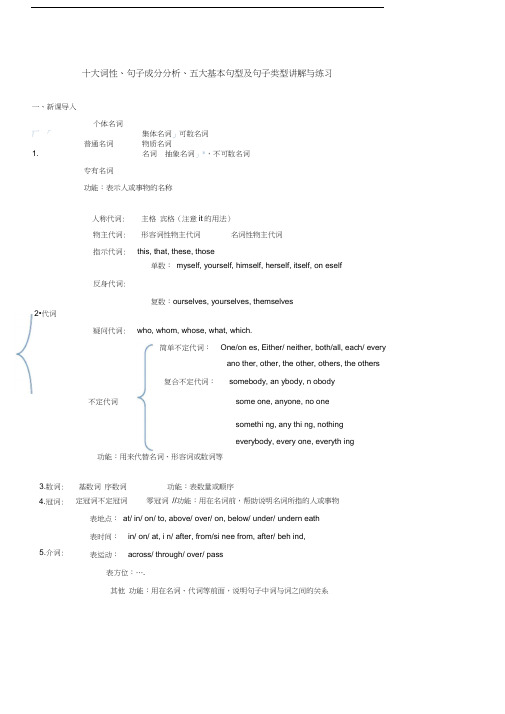
十大词性、句子成分分析、五大基本句型及句子类型讲解与练习一、新课导入个体名词厂 「集体名词」可数名词 普通名词物质名词1.名词 抽象名词」*,不可数名词专有名词功能:表示人或事物的名称单数: myself, yourself, himself, herself, itself, on eself反身代词:复数:ourselves, yourselves, themselves功能:用来代替名词、形容词或数词等定冠词不定冠词 零冠词 //功能:用在名词前,帮助说明名词所指的人或事物表地点: at/ in/ on/ to, above/ over/ on, below/ under/ undern eath 表时间: in/ on/ at, i n/ after, from/si nee from, after/ beh ind,表运动: across/ through/ over/ pass表方位:….其他 功能:用在名词、代词等前面,说明句子中词与词之间的关系人称代词: 主格 宾格(注意it 的用法) 物主代词:形容词性物主代词名词性物主代词指示代词: this, that, these, those2•代词疑问代词: who, whom, whose, what, which.简单不定代词: One/on es, Either/ neither, both/all, each/ everyano ther, other, the other, others, the others复合不定代词:somebody, an ybody, n obody some one, anyone, no one somethi ng, any thi ng, nothing everybody, every one, everyth ing3.数词:基数词 序数词 功能:表数量或顺序4.冠词:5.介词:不定代词8. 6.形容词:平级、比较级、最高级功能:用来修饰名词,表示人或事物的特性、性质7.副词:平级、比较级、最高级功能:用来修饰动词、形容词或其他副词,表示动作或形状的特性连词:9.动词:并歹U 连词: and/ both/ or/ not only …but also, but/however/ yet/ still/ while从属连词:if/ uni ess, because/as/ since, although/though 功能:用来连接词、短语或句子实义动词 (vi./vt.) 系动词 助动词情态动词不定式(to do )非谓语动词分词:现在分词(-ing )和 过去分词(-ed )I 动名词(-ing )功能:表示人或事物的动作或状态oh ah well …功能:表示说话时的感情或口气课前小测:1. 句子成分摸底测试:(1)指出下列句子划线部分是句子的什么成分?1) The stude nts got on the school bus.2) He han ded me the n ewspaper.3) I shall an swer your questi ons after class.4) What a beautiful Chin ese pain ti ng!5) They went hun ti ng together early in the morning.(2)判断下列句子是简单句并列句还是复合句?1) We ofte n study Chin ese history on Friday after noon.2) The boy who offered me his seat is called Tom.3) There is a chair in this room, isn ' t there?4) My brother and I go to school at half past seve n in the morning.5) He is in Class One and I am in Class Two.:新课讲解:(一)句子成分七种句子成分:主语、谓语、宾语(直接宾语、间接宾语)、定语、状语、补语、表语等。
英语十大词性、句子成分及五种基本句型

英语十大词性、句子成分及五种基本句型模块一:句子结构【重点】一、词性的概念:英语中的单词根据词义、句法作用和形式特征所作的分类。
共有十类:名词、动词、形容词、代词、数词、冠词、副词、介词、连词、感叹词。
1、名词,"名"就是名称---人或事物的名称.具体的人或物体的名称:人名---Mike,LiMing;地名—America, China 动物名---pig, dog; 植物名---t ree,wheat。
抽象的事物的名称:idea(主意),victory(胜利), knowledge(知识).2、代词,何谓“代”?即是替代的意思,主要是来替代名词,所以说名词和代词关系是很近的,或者说代词的实质就是名词,正是这种血液关系,绝大多数时候代词跟名词在句中起的作用是一样的。
代词,从英语词汇的整体来看数量并不多。
3、动词,"动"就是动作--人的五官动作: walk,jump, swim;人的大脑动作(心理活动): think, imagine。
也有些动词是表示静止的,如:am,is, are。
4、形容词,我们在谈论人或物时,常说:“你描述一下是什么样子。
”你就要用上:tall(高的),short矮的),black(黑的),white(白的)这些词往往是修饰名词,它们就是形容词。
5、副词,说人行走得快慢,讲话清楚,在英语里就要用quickly(快地),slowly(慢地),clearly(清楚地)这些词往往来修饰动词。
它们就是副词。
副词很多是从形容词加ly构成的,所以看单词词尾是否有ly 是判断是否是副词的一种方法,但是词尾是ly的也不一定都是副词,可能是形容词,不过只有少量的单词(常见的有likely,friendly love ly,lonely,weekly,monthly,yearly ),这几个单词需要加强记忆,也不就是几个单词特殊嘛,不过考试往往就考特殊的,你要小心才是呀!6、介词,英语用词里介词也属于难缠的一个。
十大词性句子成分及基本句型讲解及练习(附答案)
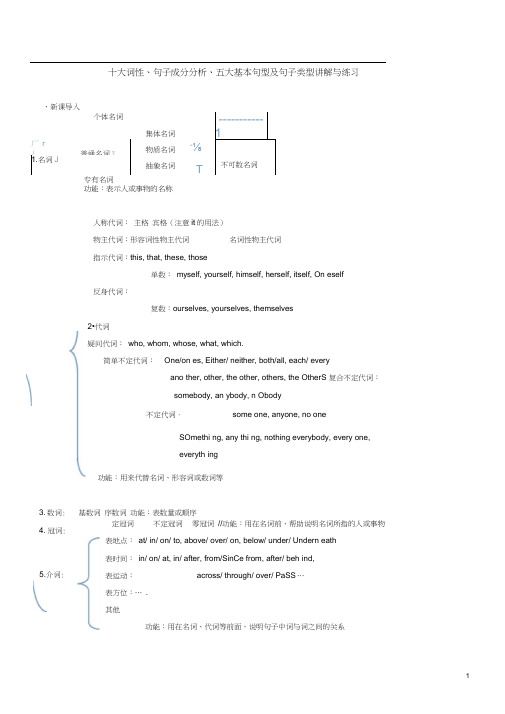
十大词性、句子成分分析、五大基本句型及句子类型讲解与练习个体名词集体名词----------- 1厂 r /普通名词Y物质名词 -⅛1.名词J抽象名词IT不可数名词功能:表示人或事物的名称人称代词: 主格 宾格(注意it 的用法) 物主代词:形容词性物主代词 名词性物主代词指示代词:this, that, these, those单数: myself, yourself, himself, herself, itself, On eself反身代词:复数:ourselves, yourselves, themselves2•代词疑问代词: who, whom, whose, what, which.简单不定代词: One/on es, Either/ neither, both/all, each/ everyano ther, other, the other, others, the OtherS 复合不定代词:somebody, an ybody, n Obody不定代词、some one, anyone, no oneSOmethi ng, any thi ng, nothing everybody, every one, everyth ing功能:用来代替名词、形容词或数词等定冠词 不定冠词 零冠词 //功能:用在名词前,帮助说明名词所指的人或事物表地点: at/ in/ on/ to, above/ over/ on, below/ under/ Undern eath 表时间: in/ on/ at, in/ after, from/SinCe from, after/ beh ind,表运动: across/ through/ over/ PaSS …表方位:… . 其他功能:用在名词、代词等前面,说明句子中词与词之间的关系3. 数词:4. 冠词:基数词 序数词 功能:表数量或顺序5.介词:6.形容词:平级、比较级、最高级8. 功能:用来修饰名词,表示人或事物的特性、性质7.副词:平级、比较级、最高级功能:用来修饰动词、形容词或其他副词,表示动作或形状的特性并歹U连词:and/ both/ or/ not only …but also, but/however/ yet/ still/ while 连词:从属连词:if/ Unless, because/as/ since, although/though功能:用来连接词、短语或句子实义动词(vi./vt.)系动词助动词9.动词:情态动词不定式(to do )非谓语动词彳分词:现在分词(-ing )和过去分词(-ed )L 动名词(-ing )功能:表示人或事物的动作或状态10.感叹词:Oh ah well功能:表示说话时的感情或口气课前小测:1. 句子成分摸底测试:(1)指出下列句子划线部分是句子的什么成分?1) The StUde nts got On the school bus.2) He han ded me the n ewspaper.3) I shall an SWer your questi OnS after class.4) What a beautiful Chin ese Pain ti ng!5) They WenthUn ti ng together early in the morning.(2)判断下列句子是简单句并列句还是复合句?1) We ofte n StUdy Chin ese history On Friday after noon.2) The boy who Offered me his Seat is called Tom.3) There is a Chair in this room, isn ' t there?4) My brother and I go to school at half PaSt SeVe n in the morning.5) He is in Class One and I am in Class Two.:新课讲解:(一)句子成分七种句子成分:主语、谓语、宾语(直接宾语、间接宾语)、定语、状语、补语、表语等。
英语十大词性、句子成分及 五种基本句型

模块一:句子结构【重点】一、词性的概念:英语中的单词根据词义、句法作用和形式特征所作的分类。
共有十类:名词、动词、形容词、代词、数词、冠词、副词、介词、连词、感叹词。
1、名词,"名"就是名称---人或事物的名称.具体的人或物体的名称:人名---Mike, Li Ming; 地名—America, China 动物名---pig, dog; 植物名---tree, wheat。
抽象的事物的名称:idea(主意), victory(胜利), knowledge(知识).2、代词,何谓“代” ?即是替代的意思,主要是来替代名词,所以说名词和代词关系是很近的,或者说代词的实质就是名词,正是这种血液关系,绝大多数时候代词跟名词在句中起的作用是一样的。
代词,从英语词汇的整体来看数量并不多。
3、动词,"动"就是动作--人的五官动作: walk, jump, swim;人的大脑动作(心理活动): think, imagine。
也有些动词是表示静止的,如:am,is, are。
4、形容词,我们在谈论人或物时,常说:“你描述一下是什么样子。
”你就要用上:tall(高的),short矮的),black(黑的),white(白的)这些词往往是修饰名词,它们就是形容词。
5、副词,说人行走得快慢,讲话清楚,在英语里就要用quickly(快地),slowly(慢地),clearly(清楚地)这些词往往来修饰动词。
它们就是副词。
副词很多是从形容词加ly构成的,所以看单词词尾是否有ly是判断是否是副词的一种方法,但是词尾是ly的也不一定都是副词,可能是形容词,不过只有少量的单词(常见的有likely,friendly lovely,lonely,weekly,monthly,yearly ), 这几个单词需要加强记忆,也不就是几个单词特殊嘛,不过考试往往就考特殊的,你要小心才是呀!6、介词,英语用词里介词也属于难缠的一个。
英语句子成分分析 十大词类及练习

英语句子成分分析之十大词类及练习一、为什么分析英语句子成分:1. 不是强调英语语法很重要2. 不是否定语感不靠谱3. 而是用理性和有逻辑方式去增强英语能力4. 提高阅读英语句子的能力(如:不懂的词,可以靠句子成分或结构来推测)5. 培养英语思维(很重要,很必要)二、英语句子结构的简单认识语法我们主要是说英语句子结构的分析,因为即使是你单词认识,句子中大部分单词都认识,可是句子还是看不懂,这是因为你不知道哪个单词和哪个单词是放在一起的或者是分不开句子的缘故。
那么什么是句子结构呢?说白了,就是在一个句子内部,一个个单词是怎么组织在一起的,为什么有的单词放在句子前面,有的单词放在句子的后面;在一个复杂的句子中各个句子是怎么组合起来的。
常见典型错句:I am very like English (我是非常喜欢英语) 。
My English very well(我的英语非常好)错在哪里?对于英语句子结构来说,我们要掌握什么呢?首先你头脑中要有词类的概念(每一个单词都是什么词性),然后学会简单句五种基本句型及句子成分的分析,再然后就是并列句和复合句的分析三、词类概念建立以及词类分析能力的培养一个词的词性不止一个,通常有两个或两个以上:例如work 可以作名词或动词,但这个词一旦放在句中,它的词性就确定了,例如: His work is good. 本句中的work是名词。
所以简单来说,词类概念的建立以及词类分析能力是指:看到一个词,立刻就能反应出这个词属于哪个词类;看到句子中的单词,立刻就能确定出这个词的词性。
这是一项能力,不可能通过死记硬背学会的。
怎么才能建立词类概念以及具备词类分析能力呢?1. 从词类概念的本身出发去分析单词的词性例子,cake 这个词,中文意思:蛋糕,是一种食品的名称,,ok 了,不用再去背cake 名词cake 名词。
这一方法的运用需要你把对单词中文意思的了解和对十大词类概念的理解两者结合起来才能运用自如。
初中英语十大词性详解和练习
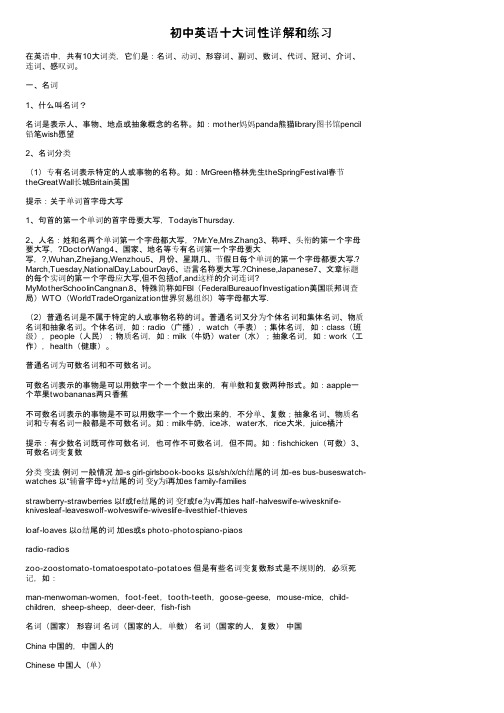
初中英语十大词性详解和练习在英语中,共有10大词类,它们是:名词、动词、形容词、副词、数词、代词、冠词、介词、连词、感叹词。
一、名词1、什么叫名词?名词是表示人、事物、地点或抽象概念的名称。
如:mother妈妈panda熊猫library图书馆pencil 铅笔wish愿望2、名词分类(1)专有名词表示特定的人或事物的名称。
如:MrGreen格林先生theSpringFestival春节theGreatWall长城Britain英国提示:关于单词首字母大写1、句首的第一个单词的首字母要大写,TodayisThursday.2、人名:姓和名两个单词第一个字母都大写,?Mr.Ye,Mrs.Zhang3、称呼、头衔的第一个字母要大写,?DoctorWang4、国家、地名等专有名词第一个字母要大写,?,Wuhan,Zhejiang,Wenzhou5、月份、星期几、节假日每个单词的第一个字母都要大写.? March,Tuesday,NationalDay,LabourDay6、语言名称要大写.?Chinese,Japanese7、文章标题的每个实词的第一个字母应大写,但不包括of,and这样的介词连词? MyMotherSchoolinCangnan.8、特殊简称如FBI(FederalBureauofInvestigation美国联邦调查局)WTO(WorldTradeOrganization世界贸易组织)等字母都大写.(2)普通名词是不属于特定的人或事物名称的词。
普通名词又分为个体名词和集体名词、物质名词和抽象名词。
个体名词,如:radio(广播),watch(手表);集体名词,如:class(班级),people(人民);物质名词,如:milk(牛奶)water(水);抽象名词,如:work(工作),health(健康)。
普通名词为可数名词和不可数名词。
可数名词表示的事物是可以用数字一个一个数出来的,有单数和复数两种形式。
十大词性-句子成分及基本句型讲解及练习(附答案)(汇编)
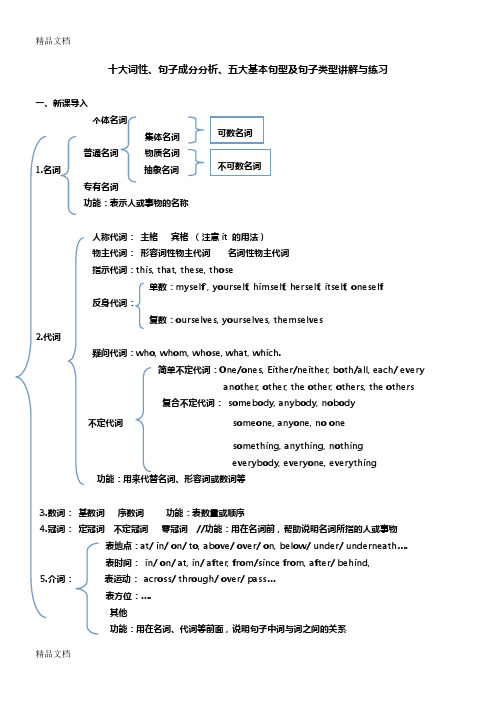
十大词性、句子成分分析、五大基本句型及句子类型讲解与练习一、新课导入个体名词集体名词普通名词 物质名词1.名词 抽象名词专有名词功能:表示人或事物的名称人称代词: 主格 宾格 (注意it 的用法)物主代词: 形容词性物主代词 名词性物主代词指示代词:this, that, these, those单数:myself`, yourself, himself, herself, itself, oneself反身代词:复数:ourselves, yourselves, themselves2.代词疑问代词:who, whom, whose, what, which.简单不定代词:One/ones, Either/neither, both/all, each/ everyanother, other, the other, others, the others复合不定代词: somebody, anybody, nobody不定代词 someone, anyone, no onesomething, anything, nothingeverybody, everyone, everything功能:用来代替名词、形容词或数词等3.数词: 基数词 序数词 功能:表数量或顺序4.冠词: 定冠词 不定冠词 零冠词 //功能:用在名词前,帮助说明名词所指的人或事物表地点:at/ in/ on/ to, above/ over/ on, below/ under/ underneath ….表时间: in/ on/ at, in/ after, from/since from, after/ behind,5.介词: 表运动: across/ through/ over/ pass …表方位:….其他功能:用在名词、代词等前面,说明句子中词与词之间的关系可数名词不可数名词6.形容词:平级、比较级、最高级功能:用来修饰名词,表示人或事物的特性、性质7. 副词:平级、比较级、最高级功能:用来修饰动词、形容词或其他副词,表示动作或形状的特性并列连词:and/ both/ or/ not only…but also, but/however/ yet/ still/ while…8. 连词:从属连词: if/ unless, because/as/ since, although/though…功能:用来连接词、短语或句子实义动词(vi./vt.)系动词助动词9. 动词:情态动词不定式(to do)非谓语动词分词: 现在分词(-ing)和过去分词(-ed)动名词(-ing)功能:表示人或事物的动作或状态10. 感叹词:oh ah well…功能:表示说话时的感情或口气课前小测:1.句子成分摸底测试:(1)指出下列句子划线部分是句子的什么成分?1)The students got on the school bus.2)He handed me the newspaper.3)I shall answer your questions after class.4)What a beautiful Chinese painting!5)They went hunting together early in the morning.(2)判断下列句子是简单句并列句还是复合句?1)We often study Chinese history on Friday afternoon.2)The boy who offered me his seat is called Tom.3)There is a chair in this room, isn’t there?4)My brother and I go to school at half past seven in the morning.5)He is in Class One and I am in Class Two.二:新课讲解:(一)句子成分七种句子成分:主语、谓语、宾语(直接宾语、间接宾语)、定语、状语、补语、表语等。
十大词类五种句型句子成分

一、十大词类和物种基本句型及句子成分1.十大词类1可作主语、表语、宾语、定语、补语、同位语。
例:Our monitor is reading a novel.Tom is our monitor.I will invite our monitor to dinner.The monitor is monitoring us on his monitor system.We elected Tom monitor.Tom, our monitor, will attend the class meeting.2可作主语、定语、表语、宾语、同位语。
例:I have bought these books,so they are mine and I learn themmyself.3可作定语、表语、补语。
例:We love ourbeautiful school.Our school is beautiful.We want to make our school more beautiful.4可作状语、表语修饰动词、形容词、副词。
例:The young always live in a world of fantasy.The old lady was especially beautiful in her day.They get on very well with each other.5可作谓语表示动作或状态。
例:We should cherish the flowers and plants.Time and tide wait for no man.Failure is the mother of success.We can’t depend on our parents all our life.He has learned English for6 years.6可作主语、宾语、表语、定语。
十大词性句子成分及基本句型讲解及练习(附答案)
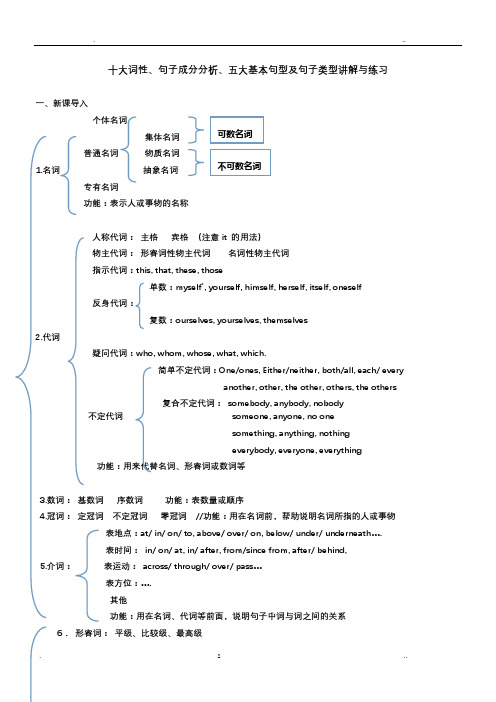
十大词性、句子成分分析、五大基本句型及句子类型讲解与练习一、新课导入个体名词集体名词普通名词 物质名词1.名词 抽象名词专有名词功能:表示人或事物的名称人称代词: 主格 宾格 (注意it 的用法)物主代词: 形容词性物主代词 名词性物主代词指示代词:this, that, these, those单数:myself`, yourself, himself, herself, itself, oneself反身代词:复数:ourselves, yourselves, themselves2.代词疑问代词:who, whom, whose, what, which.简单不定代词:One/ones, Either/neither, both/all, each/ everyanother, other, the other, others, the others复合不定代词: somebody, anybody, nobody不定代词 someone, anyone, no onesomething, anything, nothingeverybody, everyone, everything功能:用来代替名词、形容词或数词等3.数词: 基数词 序数词 功能:表数量或顺序4.冠词: 定冠词 不定冠词 零冠词 //功能:用在名词前,帮助说明名词所指的人或事物表地点:at/ in/ on/ to, above/ over/ on, below/ under/ underneath ….表时间: in/ on/ at, in/ after, from/since from, after/ behind,5.介词: 表运动: across/ through/ over/ pass …表方位:….其他功能:用在名词、代词等前面,说明句子中词与词之间的关系6. 形容词: 平级、比较级、最高级功能:用来修饰名词,表示人或事物的特性、性质7. 副词:平级、比较级、最高级功能:用来修饰动词、形容词或其他副词,表示动作或形状的特性并列连词:and/ both/ or/ not only…but also, but/however/ yet/ still/ while…8. 连词:从属连词: if/ unless, because/as/ since, although/though…功能:用来连接词、短语或句子实义动词(vi./vt.)系动词助动词9. 动词:情态动词不定式(to do)非谓语动词分词: 现在分词(-ing)和过去分词(-ed)动名词(-ing)功能:表示人或事物的动作或状态10. 感叹词:oh ah well…功能:表示说话时的感情或口气课前小测:1.句子成分摸底测试:(1)指出下列句子划线部分是句子的什么成分?1)The students got on the school bus.2)He handed me the newspaper.3)I shall answer your questions after class.4)What a beautiful Chinese painting!5)They went hunting together early in the morning.(2)判断下列句子是简单句并列句还是复合句?1)We often study Chinese history on Friday afternoon.2)The boy who offered me his seat is called Tom.3)There is a chair in this room, isn’t there?4)My brother and I go to school at half past seven in the morning.5)He is in Class One and I am in Class Two.二:新课讲解:(一)句子成分七种句子成分:主语、谓语、宾语(直接宾语、间接宾语)、定语、状语、补语、表语等。
英语十大词类的用法及句子成分详解

英语十大词类的用法及句子成分详解一.英语的词类的意义及用法:1.名词Noun (n.):表示人或事物的名称。
在句子中常作主语、宾语、表语、定语、补足语、称呼语、同位语等。
如,pen, boy等。
2.代词Pronoun (pron.):用来代替名词、形容词或数词。
在句子中常作主语、宾语、表语、定语、补足语、称呼语、同位语等。
如,we, that, what等。
3.动词Verb(v.):表示动作或状态。
作谓语和补足语。
如,walk, have, is等。
4.数词Numeral (num.):表示数量或顺序(基数词表示数量,序数词表示顺序)。
在句子中常作主语、宾语、表语、定语、同位语等。
如,two, second等。
5.形容词Adjective (adj.):用以修饰说明名词或代词,表示人或事物的特征。
在句子中常作定语、表语、状语、宾语补足语等。
如,good, red,nice等。
6.副词Adverb (adv.):用以修饰说明动词、形容词或其它副词。
在句子中常作状语和补语,有时候也可作表语。
如,often, very等。
7.介词Preposition (prep.):用在名词、代词之前,说明表示名词、代词和句中其它词的关系。
不能单独作句子成分,必须和其他词连用,后跟动词时,必须用动词的ing形式。
如,at, on, in, for,to, under等。
8.冠词Article (art.):用在名词之前,帮助说明名词所指的人或事物是泛指(类别)还是特指。
不能单独作句子成分,必须和名词、形容词、数词连用。
如,a(用在以辅音音素开头的单词前,表示泛指“一…….”), an(用在以元音音素开头的单词前,表示泛指“一…….”); the(表示特指“这…….;这个…….=this;那…..;那个….=that;这些……=these;那些……=those”;包含了this、that、these、those的意思)9.连词Conjunction (conj.):用来连接词与词、短语与短语或句子与句子。
- 1、下载文档前请自行甄别文档内容的完整性,平台不提供额外的编辑、内容补充、找答案等附加服务。
- 2、"仅部分预览"的文档,不可在线预览部分如存在完整性等问题,可反馈申请退款(可完整预览的文档不适用该条件!)。
- 3、如文档侵犯您的权益,请联系客服反馈,我们会尽快为您处理(人工客服工作时间:9:00-18:30)。
十大词性、句子成分分析、五大基本句型及句子类型讲解与练习一、新课导入个体名词集体名词 普通名词 物质名词 1.名词 抽象名词 专有名词功能:表示人或事物的名称人称代词: 主格 宾格 (注意it 的用法) 物主代词: 形容词性物主代词 名词性物主代词 指示代词:this, that, these, those单数:myself`, yourself, himself, herself, itself, oneself反身代词:复数:ourselves, yourselves, themselves 2.代词疑问代词:who, whom, whose, what, which.简单不定代词:One/ones, Either/neither, both/all, each/ everyanother, other, the other, others, the others复合不定代词: somebody, anybody, nobody 不定代词 someone, anyone, no one something, anything, nothing everybody, everyone, everything 功能:用来代替名词、形容词或数词等3.数词: 基数词 序数词 功能:表数量或顺序4.冠词: 定冠词 不定冠词 零冠词 //功能:用在名词前,帮助说明名词所指的人或事物 表地点:at/ in/ on/ to, above/ over/ on, below/ under/ underneath …. 表时间: in/ on/ at, in/ after, from/since from, after/ behind,5.介词: 表运动: across/ through/ over/ pass …表方位:….其他功能:用在名词、代词等前面,说明句子中词与词之间的关系可数名词 不可数名词6.形容词:平级、比较级、最高级功能:用来修饰名词,表示人或事物的特性、性质7. 副词:平级、比较级、最高级功能:用来修饰动词、形容词或其他副词,表示动作或形状的特性并列连词:and/ both/ or/ not only…but also, but/however/ yet/ still/ while…8. 连词:从属连词: if/ unless, because/as/ since, although/though…功能:用来连接词、短语或句子实义动词(vi./vt.)系动词助动词9. 动词:情态动词不定式(to do)非谓语动词分词: 现在分词(-ing)和过去分词(-ed)动名词(-ing)功能:表示人或事物的动作或状态10. 感叹词:oh ah well…功能:表示说话时的感情或口气课前小测:1.句子成分摸底测试:(1)指出下列句子划线部分是句子的什么成分?1)The students got on the school bus.2)He handed me the newspaper.3)I shall answer your questions after class.4)What a beautiful Chinese painting!5)They went hunting together early in the morning.(2)判断下列句子是简单句并列句还是复合句?1)We often study Chinese history on Friday afternoon.2)The boy who offered me his seat is called Tom.3)There is a chair in this room, isn’t there?4)My brother and I go to school at half past seven in the morning.5)He is in Class One and I am in Class Two.二:新课讲解:(一)句子成分七种句子成分:主语、谓语、宾语(直接宾语、间接宾语)、定语、状语、补语、表语等。
句子的主要部分是主语和谓语。
表语、宾语和补足语是谓语的组成部分。
其他成分如定语、状语、同位语是句子的次要成分。
1.主语(话题/主心骨)一句话的主体。
英语句子不可或缺的成分,是全句述说的主题。
常用的作主语的词类有:名词(短语)、代词、数词、名词化的形容词,不定式(短语)、动名词(短语)和从句。
George is a born leader. (名词)Nobody knew what had happened. (代词)Two of us will attend the conference tomorrow. (数词)The young are always willing to accept new things. (名词化的形容词)To go the bed early and to get up early is a good habit. (不定式短语)Losing his new MP4 made Tom very sad. (动名词短语)What we can’t get seems better than what we have. (名词性从句)It is necessary to master a foreign language. (不定式做主语)总结:正常语序情况下,主语在谓语动词之前。
2.谓语(动作/状态):说明主语做了什么动作,干了啥事。
位于主语之后。
谓语动词有人称、数、时态和语态等的变化。
简单谓语:由一个动词或动词短语构成。
Father cooks very well.He practices running every morning.复合谓语:由情态动词或其他助动词加动词原形构成。
My sister has worked in the company for five years.You may keep the book for two weeks.总结:谓语部分由动词,动词短语或系表结构构成。
3.宾语(被K 的对象——主语发出的各种动作都落在宾语身上)及物动词动作的对象和介词所联系的对象。
英语有单宾语、双宾语、复合宾语、同源宾语等。
双宾语又分为直接宾语和间接宾语。
凡能做主语的词、短语或从句都可以作宾语。
(1)单宾语(宾语)可以作宾语的成分主要有名词(短语)、代词、数词、名词化的形容词、名词化的分词、不定式(短语)、动名词(短语)、从句等。
I can hardly hear the radio. Would you please turn it up? (名词、代词)If you put 5 and 7 together, you’ll get 12, little Tom. (代词)We should help the poor. (名词化的形容词)Remember to tell him to come. (不定式)Please stop making noise. (动名词)Do you understand what I mean? (名词性从句)(2)双宾语(直接宾语&间接宾语)双宾语指动词后面接指人和物的两个宾语。
指人的宾语叫间接宾语,指物的宾语叫直接宾语。
其结构为:主语+ 及物动词(短语)+ sb. + sth.Please tell me how the accident came about.The teacher asked me a question too difficult to answer.(3)同源宾语少数不及物动词后面能跟一个特定的名词作宾语,这个名词和前面的动词在词根上相同的或者在意义上是相近的,这样的宾语就叫做同源宾语。
同源宾语前面常有修饰语。
laugh a good laugh 大笑blow a heavy blow 沉重的一击smile a sweet smile 甜甜的微笑dream a terrible dream 做了一个恶梦die a brave death 死得英勇live a happy life 过着幸福的生活4.表语(在系动词之后)说明主语是什么样的。
(身份状态特征类属性质等)表语与前面的系动词一起构成谓语。
His father is an experienced teacher. (名词)She is over fifty, but she doesn’t look it. (名词、代词)These students are careful while others are careless. (形容词)The class meeting was over at last. (副词)Be quiet; they are at work now. (介词短语)His hobby is collecting foreign stamps. (动名词短语)My wish is to become a doctor in the future. (不定式短语)The news of her success is really exciting. (现在分词)(已形容词化)That is where your mistakes are. (名词性从句)总结: 与系动词一起构成谓语。
5.定语(商品外包装——起修饰作用)定语是用来描述名词或代词的修饰语,它常和名词构成名词短语。
定语可分为前置定语和后置定语两种。
(1)前置定语可以充当前置定语的有形容词、代词、数词、名词和名词所有格、动词的-ing形式、动词的-ed形式等。
Many people have helped with (canned) food. (过去分词)Open (your) mouth and put out (your) tongue. (代词的所有格)She cut the cake into (two) pieces. (数词)I want to buy some (coffee) cups. (名词)Put the child in the (sleeping) bag. (动名词)You should adapt to the (changing) situation. (现在分词)(2)后置定语可以充当后置定语的有形容词,副词,介词短语,不定式(短语),动词的-ing短语,动词的-ed短语,从句等。
All people (present at the party) were his supporters. (形容词短语)I have got something (interesting) to tell every one of you. (形容词)The buildings (around) were badly damaged. (副词)The books (on the top shelf) were just bought. (介词短语)Let’s try another way (to do this). (不定式)There is a gentleman (asking to see you). (现在分词短语)Most of the people (invited to the party) were famous scientists. (过去分词)He lost his new pen (that was bought last week). (定语从句)6. 状语(商品标签)状语是用来修饰动词,形容词,副词或句子的一种句子成分。
